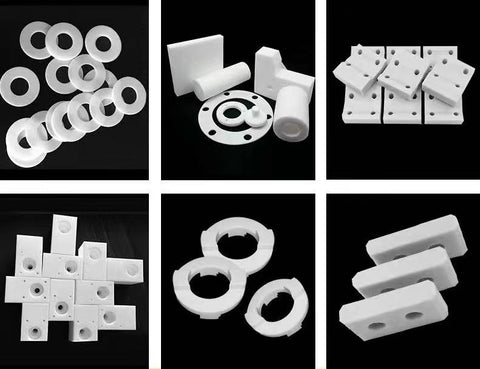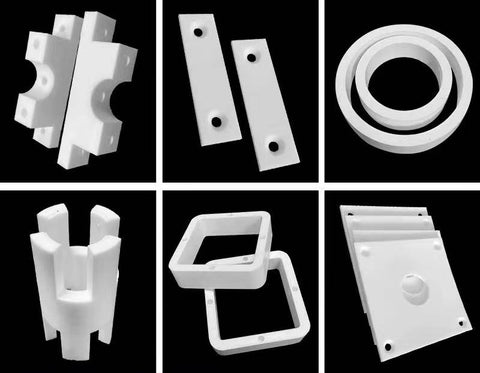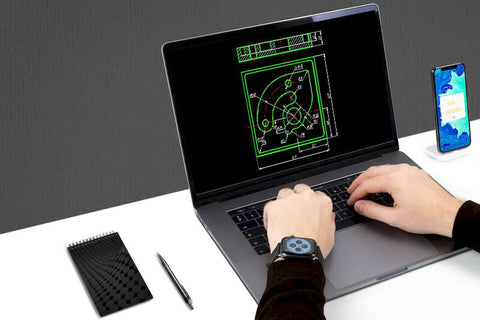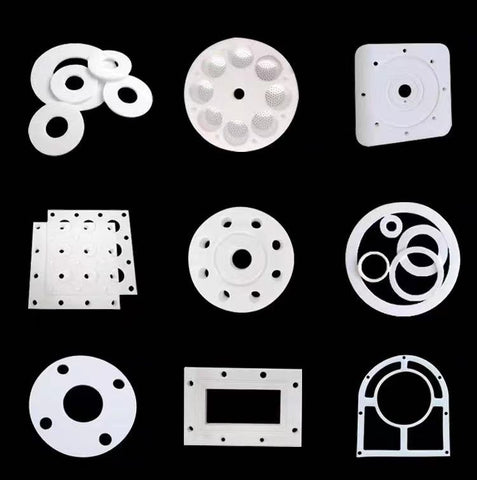In the blog post "Designing the Future: The Benefits of CNC Machined PTFE Parts for Innovative Creations," we embark on an enlightening journey through the world of CNC machined PTFE parts, a cornerstone in modern product design. We begin by Understanding CNC Machined PTFE Parts, offering a comprehensive overview that demystifies this material's unique properties and its significance in innovative design.

Delving deeper, we explore The Role of CNC Machined PTFE in Modern Manufacturing Processes, highlighting how CNC machining has revolutionized manufacturing, bringing unmatched precision and customization capabilities. This leads us to the heart of creativity in Innovative Applications of CNC Machined PTFE in Product Design, where we showcase a range of groundbreaking uses of CNC machined PTFE, from intricate components in electronics to bespoke parts in automotive design.
A critical comparison comes next in Comparing CNC Machined PTFE with Other Materials: A Designer’s Perspective. Here, we weigh the advantages and potential limitations of CNC machined PTFE against other traditional materials, providing a balanced view for product designers.
Finally, we gaze into the crystal ball with Future Trends: The Evolving Landscape of CNC Machined PTFE in Design. This section predicts emerging trends and potential new applications, painting a picture of how CNC machined PTFE parts will continue to shape the future of product design and innovation.
This post is not just a read; it's an expedition into the future of design, highlighting the pivotal role of CNC machined PTFE parts in pushing the boundaries of creativity and functionality in product design.
Understanding CNC Machined PTFE Parts: An Overview for Product Designers
In the realm of modern product design, the use of CNC machined PTFE parts stands out as a game-changer. This section delves into the essentials of CNC machined PTFE, highlighting its unique properties and significance in the world of design.

What are CNC Machined PTFE Parts?
CNC (Computer Numerical Control) machining is a process used to manufacture precision parts. When applied to PTFE (Polytetrafluoroethylene), a material renowned for its high resistance to heat, chemicals, and electricity, it results in parts that are not only precise but also highly durable. These CNC machined PTFE parts are crafted using advanced computer-controlled machinery, ensuring unparalleled accuracy and consistency.
Unique Properties of CNC Machined PTFE
One of the standout features of CNC machined PTFE is its exceptional resistance to extreme temperatures. This makes it an ideal choice for applications in challenging environments. Additionally, its non-stick surface and chemical inertness make it suitable for use in the food industry, medical field, and beyond. The material's low friction coefficient also means that parts made from PTFE operate smoothly, with minimal wear and tear.
Why CNC Machined PTFE is Significant in Product Design
For product designers, CNC machined PTFE parts offer a multitude of benefits. Their precision and reliability make them indispensable in creating complex components where tolerances are tight. This precision allows designers to push the boundaries of innovation, knowing that the parts can be manufactured to exact specifications. Furthermore, the versatility of PTFE means it can be used in a wide range of applications, from aerospace components to household appliances.
The Impact of CNC Machining on PTFE Parts
The impact of CNC machining on PTFE cannot be overstated. This technology has transformed how PTFE parts are made, allowing for more complex and intricate designs that were previously impossible. The ability to produce consistent, high-quality parts quickly and efficiently is a significant advantage in today's fast-paced market.
Embracing CNC Machined PTFE in Design
In conclusion, CNC machined PTFE parts represent a significant advancement in the field of product design. Their unique properties, combined with the precision of CNC machining, open up new possibilities for designers to explore. As we continue to push the limits of what's possible, CNC machined PTFE will undoubtedly play a crucial role in the future of design and manufacturing.
The Role of CNC Machined PTFE in Modern Manufacturing Processes
The integration of CNC machined PTFE into modern manufacturing processes marks a significant evolution in the production of high-performance parts. This section explores how CNC machining has revolutionized the use of PTFE, focusing on the precision and customization it offers.

Revolutionizing Manufacturing with CNC Machined PTFE
CNC machining has transformed the landscape of manufacturing, particularly with materials like PTFE (Polytetrafluoroethylene). This advanced manufacturing technique uses computer-controlled systems to ensure high precision in producing parts. When applied to PTFE, a material known for its versatility and durability, CNC machining opens up a world of possibilities in manufacturing.
Precision: The Hallmark of CNC Machined PTFE
One of the most significant advantages of using CNC machined PTFE is the level of precision it brings to manufacturing. CNC machines can produce parts with extremely tight tolerances, essential in industries where precision is paramount, such as aerospace, automotive, and medical devices. This precision ensures that each part is consistent, fitting perfectly into its intended application without the need for adjustments.
Customization Capabilities of CNC Machining
Another key benefit of CNC machining in the context of PTFE is its customization capabilities. Unlike traditional manufacturing methods, CNC machines can easily be programmed to produce complex shapes and designs. This flexibility allows manufacturers to create bespoke PTFE parts tailored to specific requirements, making it an ideal solution for custom projects and innovative applications.
Enhancing Efficiency and Reducing Wast
CNC machining not only offers precision and customization but also enhances efficiency in the manufacturing process. The high level of accuracy reduces material waste, as parts are made exactly to specification. This efficiency is particularly beneficial when working with PTFE, a valuable material, ensuring that every bit is utilized effectively.
CNC Machined PTFE - A Cornerstone in Modern Manufacturing
In conclusion, the role of CNC machined PTFE in modern manufacturing processes cannot be overstated. Its ability to deliver precision, customization, and efficiency has made it a cornerstone in the production of high-quality, reliable parts. As manufacturing continues to evolve, the use of CNC machined PTFE is set to grow, further revolutionizing the industry and paving the way for more innovative and effective manufacturing solutions.
Innovative Applications of CNC Machined PTFE in Product Design
The versatility of CNC machined PTFE has opened up a plethora of innovative applications in product design. This section highlights various ways in which product designers are incorporating CNC machined PTFE parts into their creations, showcasing specific case studies and examples.

Unleashing Creativity with CNC Machined PTFE
The advent of CNC machining technology has given product designers a powerful tool to realize their most creative ideas, especially when working with PTFE (Polytetrafluoroethylene). This material's unique properties, combined with the precision of CNC machining, allow for the creation of complex, high-performance parts.
Case Study: Aerospace Industry
In the aerospace industry, the use of CNC machined PTFE parts has been groundbreaking. For instance, PTFE's high resistance to extreme temperatures and chemicals makes it ideal for components exposed to harsh environmental conditions. A notable example is the use of CNC machined PTFE in creating seals and gaskets for aircraft engines, where they ensure reliability and safety under high-stress conditions.
Automotive Applications
The automotive sector has also seen a surge in the use of CNC machined PTFE parts. Their durability and low friction coefficient make them perfect for components like gears and bearings, which require smooth operation and longevity. This application not only enhances the performance of vehicles but also contributes to their overall efficiency and lifespan.
Medical Device Innovations
In the medical field, CNC machined PTFE is used to create intricate components for various devices. Its biocompatibility makes it safe for use in medical implants and surgical instruments. For example, PTFE's non-reactive nature is ideal for creating parts of heart valves and stents, significantly improving patient outcomes.
The Future of Design with CNC Machined PTFE
In conclusion, the innovative applications of CNC machined PTFE in product design are vast and varied. From aerospace to automotive, and medical devices, the impact of this technology is profound. As designers continue to explore the potential of CNC machined PTFE, we can expect to see even more groundbreaking uses in various industries.
Comparing CNC Machined PTFE with Other Materials: A Designer’s Perspective
In the dynamic world of product design, the choice of materials plays a pivotal role. This section offers a detailed analysis of CNC machined PTFE compared to other commonly used materials, highlighting both the advantages and potential limitations from a designer's perspective.

CNC Machined PTFE vs Traditional Materials
When it comes to material selection, CNC machined PTFE stands out for several reasons. Its unique properties offer distinct advantages over more traditional materials like metals, plastics, and ceramics. Understanding these differences is crucial for designers in making informed decisions about material selection.
Advantages of CNC Machined PTFE
Superior Chemical Resistance
One of the most significant advantages of CNC machined PTFE is its exceptional chemical resistance. Unlike metals that can corrode or plastics that may degrade, PTFE remains stable in a wide range of chemical environments. This property is particularly beneficial in industries like chemical processing or where parts are exposed to corrosive substances.
High-Temperature Tolerance
Another key advantage is PTFE's ability to withstand extreme temperatures. While materials like plastics may melt or deform under high heat, CNC machined PTFE maintains its integrity, making it ideal for applications in aerospace and automotive industries.
Low Friction and Non-Stick Properties
PTFE's low friction coefficient and non-stick nature are also noteworthy. These properties reduce wear and tear, extending the lifespan of parts, a feature not always present in other materials like metals or standard plastics.
Potential Limitations of CNC Machined PTFE
Despite its many advantages, CNC machined PTFE is not without its limitations. One potential drawback is its lower strength compared to some metals, which might limit its use in applications requiring high structural integrity. Additionally, PTFE's cost can be higher than some conventional materials, which might be a consideration for budget-sensitive projects.
Comparing with Other Advanced Materials
CNC Machined PTFE vs Composites
When compared to advanced composite materials, CNC machined PTFE offers better chemical resistance but may lack the structural strength that composites provide. Composites, however, can be more expensive and less resistant to high temperatures.
CNC Machined PTFE vs Ceramics
Ceramics are known for their hardness and heat resistance, but they can be brittle. CNC machined PTFE, while not as hard, offers greater flexibility and resistance to thermal shock, making it more suitable for certain applications.
Balancing Pros and Cons in Material Selection
In conclusion, while CNC machined PTFE excels in chemical resistance, temperature tolerance, and low friction properties, it's important to balance these benefits against its strength limitations and cost. For product designers, understanding these trade-offs is key to selecting the right material for their specific needs.
Future Trends: The Evolving Landscape of CNC Machined PTFE in Design
As we look towards the future, the role of CNC machined PTFE in product design is poised for even more groundbreaking developments. This section explores the emerging trends, potential new applications, and the continuing influence of CNC machined PTFE parts in the evolving field of product design.

Emerging Trends in CNC Machined PTFE Applications
The advancement of CNC technology and material science is set to expand the capabilities and applications of CNC machined PTFE. These trends are not just shaping the present but are also paving the way for future innovations.
Integration with Smart Technology
One of the most exciting trends is the integration of CNC machined PTFE parts with smart technology. The potential for PTFE components in IoT (Internet of Things) devices and smart sensors is vast, given their durability and resistance to environmental factors. This integration could lead to more efficient, self-monitoring systems in industries ranging from automotive to home appliances.
Sustainable and Eco-Friendly Manufacturing
Sustainability is becoming increasingly important in manufacturing. The production of CNC machined PTFE is evolving to become more eco-friendly, with a focus on reducing waste and improving recycling methods. This shift not only addresses environmental concerns but also meets the growing demand for sustainable manufacturing practices.
Potential New Applications
Biomedical Advances
In the biomedical field, the use of CNC machined PTFE is expected to grow, particularly in prosthetics and implantable devices. Its biocompatibility makes it an ideal choice for medical applications, and CNC machining allows for the creation of highly customized parts tailored to individual patient needs.
Aerospace and Defense Innovations
The aerospace and defense industries are also likely to see increased use of CNC machined PTFE. Its resistance to extreme temperatures and chemicals makes it suitable for critical components in spacecraft and military equipment, where reliability is paramount.
The Future of Design with CNC Machined PTFE
Looking ahead, the possibilities for CNC machined PTFE in product design are limitless. As technology advances, we can expect to see PTFE used in more innovative and complex ways, further solidifying its role in the future of design.
A Bright Future for CNC Machined PTFE in Design
In conclusion, the future trends in CNC machined PTFE point to a landscape of innovation and advancement. From smart technology integration to sustainable manufacturing and new applications in various industries, CNC machined PTFE is set to continue its significant impact on product design.
In conclusion, our journey through the world of CNC machined PTFE in product design has revealed its remarkable versatility and potential. From revolutionizing manufacturing processes with unparalleled precision and customization to inspiring innovative applications across various industries, CNC machined PTFE stands as a testament to the power of modern engineering and design. As we look towards the future, the evolving landscape of CNC machined PTFE promises even more exciting possibilities, blending sustainability with advanced technology. For product designers and manufacturers, embracing the capabilities of CNC machined PTFE means not just keeping pace with current trends but also shaping the future of design and innovation. This exploration into CNC machined PTFE not only highlights its current significance but also ignites imagination for what is yet to come, ensuring its role as a pivotal material in the ever-evolving realm of product design.

Ready to Transform Your Designs with CNC Machined PTFE?
Let's make it happen! Share your ideas and questions with us. Fill out the contact form below and join the forefront of innovative product design. We're excited to collaborate and bring your visions to life!

